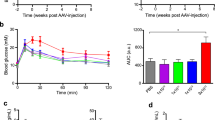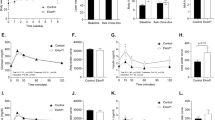Abstract
Effective and safe insulin gene therapy will require regulation of transgenic insulin secretion. We have created a liver- targeted insulin transgene by engineering glucose responsive elements into a hepatic promoter containing an inhibitory insulin response sequence. In this work, we demonstrate application of this transgene for the treatment of diabetes mellitus in vivo, by administering a recombinant adenovirus vector, Ad/(GlRE)3BP-1 2xfur, to rats made diabetic with streptozotocin. We verified hepatic expression of transgenic insulin by RT-PCR, and confirmed glucose responsive stimulation of transgenic insulin secretion in vivo by serum RIA. Following a portal system injection of either Ad/(GlRE)3BP-1 2xfur, or an empty adenoviral vector, animals made diabetic with either low (120 mg/kg), or high (290 mg/kg) dose streptozotocin (STZ) were monitored for changes in body weight, and blood glucose. Without subcutaneous insulin injections, blood glucose values of sham-treated animals (n = 8) remained elevated, and animals failed to gain weight (n = 4), or died (n = 4). In contrast, body weight of Ad/(GlRE)3BP-1 2xfur-treated animals (n = 13) increased, and blood glucose remained at near normal levels from one to 12 weeks. Glucose values <50 mg/dl were infrequently observed, and no Ad/(GlRE)3BP-1 2xfur-treated animal succumbed to hypoglycemia. Treatment with the insulin transgene enabled diabetic animals to reduce blood sugars following a glucose load, and to maintain blood sugar levels during a 10-h fast. Hepatic production of human insulin produced near normal glycemia, and weight gain, without exogenous insulin, and without lethal hypoglycemia. In conclusion, we have demonstrated the feasibility of utilizing transcription to control transgenic insulin production in a rodent model of diabetes mellitus.
This is a preview of subscription content, access via your institution
Access options
Subscribe to this journal
Receive 12 print issues and online access
$259.00 per year
only $21.58 per issue
Buy this article
- Purchase on Springer Link
- Instant access to full article PDF
Prices may be subject to local taxes which are calculated during checkout









Similar content being viewed by others
References
Eisenbarth GS . Type I diabetes mellitus: a chronic autoimmune disease New Engl J Med 1986 314: 1360–1368
Selden RF, Skoskiewicz MJ, Russell PS, Goodman HM . Regulation of insulin-gene expression New Engl J Med 1987 317: 1067–1076
Kolodka TM, Finegold M, Moss L, Woo SLC . Gene therapy for diabetes mellitus in rats by hepatic expression of insulin Proc Natl Acad Sci USA 1995 92: 3293–3297
Falqui L et al. Reversal of diabetes in mice by implantation of human fibroblasts genetically engineered to release mature human insulin Hum Gene Ther 1999 10: 1753–1762
Tuch BE et al. Transplantation of genetically engineered insulin-producing hepatocytes into immunoincompetent mice Transplant Proc 1998 30: 473
Valera A et al. Regulated expression of human insulin in the liver of transgenic mice corrects diabetic alterations FASEB J 1994 8: 440–447
Muzzin P, Eisensmith RC, Copeland KC, Woo SLC . Hepatic insulin gene expression as treatment for type 1 diabetes mellitus in rats Mol Endocrinol 1997 11: 833–837
Short DK, Okada S, Yamauchi K, Pessin JE . Adenovirus-mediated transfer of a modified human proinsulin gene reverses hyperglycemia in diabetic mice Am J Physiol 1998 275: E748–E756
Gros L et al. Insulin production by engineered muscle cells Hum Gene Ther 1999 10: 1207–1217
Thulé PM, Liu J-M, Phillips LS . Glucose regulated production of human insulin in rat heptocytes Gene Therapy 2000 7: 205–214
Groskreutz DJ, Sliwkowski MX, Gorman CM . Genetically engineered proinsulin constitutively processed and secreted as mature, active insulin J Biol Chem 1994 269: 6241–6245
Minematsu S, Watanabe M, Tsuchiya N, Amagaya S . Diurnal variations in blood chemical items in Sprague–Dawley rats Exp Anim 1995 44: 223–232
Rivera VM et al. Regulation of protein secretion through controlled aggregation in the endoplasmic reticulum Science 2000 287: 826–830
Selden R et al. Implantation of genetically engineered fibroblasts into mice: implications for gene therapy Science 1987 236: 714–718
Kaneda Y, Iwai K, Uchida T . Introduction and expression of the human insulin gene in adult rat liver J Biol Chem 1989 264: 12126–12129
Yamaguchi M et al. Insulin gene transfer compensates pancreatic α-cell function in diabetic rats Transplant Proc 1998 30: 2913
Sugiyama A et al. Defective adeno-associated viral-mediated transfection of insulin gene by direct injection into liver parenchyma decreases blood glucose of diabetic mice Horm Metab Res 1997 29: 599–603
Abai A, Hobart P, Barnhart KM . Insulin delivery with plasmid DNA Hum Gene Ther 1999 10: 2637–2649
Haughton CL, Dillehay DL, Phillips LS . Insulin replacement therapy for the rat model of streptozotocin-induced diabetes mellitus Lab Anim Sci 1999 49: 639–644
Koopmans SJ, Sips HCM, Krans HMJ, Radder JK . Pulsatile intravenous insulin replacement in streptozotocin-diabetic rats is more efficient than continuous delivery: effects on glycaemic control, insulin-mediated glucose metabolism and lipolysis Diabetologia 1996 39: 391–400
Wang RN, Bouwens L, Kloeppel G . Beta-cell proliferation in normal and streptozotocin-treated newborn rats: site, dynamics and capacity Diabetologia 1994 37: 1088–1096
Wang Q et al. Persistent transgene expression in mouse liver following in vivo gene transfer with a DeltaE1/DeltaE4 adenovirus vector Gene Therapy 1997 4: 393–400
Qin L et al. Promoter attenuation in gene therapy: interferon-gamma and tumor necrosis factor-alpha inhibit transgene expression Hum Gene Ther 1997 8: 2019–2029
Nakai H et al. Adeno-associated viral vector-mediated gene transfer of human blood coagulation factor IX in mouse liver Blood 1998 91: 4600–4607
Loser P, Jennings GS, Strauss M, Sandig V . Reactivation of the previously silenced cytomegalovirus major immediate–early promoter in the mouse liver: involvement of NF-κ-B J Virol 1998 72: 180–190
Lu D et al. Regulatable production of insulin from primary-cultured hepatocytes: insulin production is up-regulated by glucagon and cAMP and down-regulated by insulin Gene Therapy 1998 5: 888–895
Gros L et al. Regulated production of mature insulin by non-β-cells Hum Gene Ther 1997 8: 2249–2259
Wanke IE, Wong NC . Specific problems facing gene therapy for insulin-dependent diabetes mellitus: glucose-regulated insulin secretion from hepatocytes Proc West Pharmacol Soc 1997 40: 131–133
Simpson AM et al. Gene therapy of diabetes: glucose-stimulated insulin secretion in a human hepatoma cell line (HEP G2ins/g) Gene Therapy 1997 4: 1202–1215
McKeating J . Neutralization of virus. In: Collins MKL (ed) Practical Molecular Virology, vol. 1 Humana Press: Clifton, NJ 1991 pp 89–93
Seglen PO . Preparation of rat liver cells. III. Enzymatic requirements for tissue dispersion Exp Cell Res 1973 82: 391–398
Mittereder N, March KL, Trapnell BC . Evaluation of the concentration and bioactivity of adenovirus vectors for gene therapy J Virol 1996 70: 7498–7509
Acknowledgements
This work was funded by a grant from the Juvenile Diabetes Foundation International and a VA Merit Review Award and NIDDK/NRSA F32 DK08978 to PM Thulé. The authors thank David Cranford, LifeScan, Inc., for supplying the glucose test strips used in this study, and Dr Leonard Thaler for assistance with some statistical analysis. We also gratefully acknowledge Dr Timothy Stewart and Genentech, Inc., for provision of the 2xfur human insulin cDNA.
Author information
Authors and Affiliations
Rights and permissions
About this article
Cite this article
Thulé, P., Liu, JM. Regulated hepatic insulin gene therapy of STZ-diabetic rats. Gene Ther 7, 1744–1752 (2000). https://doi.org/10.1038/sj.gt.3301297
Received:
Accepted:
Published:
Issue Date:
DOI: https://doi.org/10.1038/sj.gt.3301297
Keywords
This article is cited by
-
Regenerative medicine and cell-based approaches to restore pancreatic function
Nature Reviews Gastroenterology & Hepatology (2017)
-
Hepatic insulin gene therapy prevents diabetic enteropathy in STZ-treated CD-1 mice
Molecular Therapy - Methods & Clinical Development (2015)
-
Engineering an L-cell line that expresses insulin under the control of the glucagon-like peptide-1 promoter for diabetes treatment
BMC Biotechnology (2011)
-
Remission of Diabetes by Insulin Gene Therapy Using a Hepatocyte-specific and Glucose-responsive Synthetic Promoter
Molecular Therapy (2011)
-
Hepatic Insulin Gene Therapy Normalizes Diurnal Fluctuation of Oxidative Metabolism in Diabetic BB/Wor Rats
Molecular Therapy (2008)



